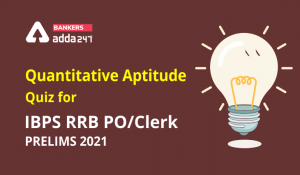Dear Aspirants,
Numerical Ability or Quantitative Aptitude Section has given heebie-jeebies to the aspirants when they appear for a banking examination. As the level of every other section is only getting complex and convoluted, there is no doubt that this section, too, makes your blood run cold. The questions asked in this section are calculative and very time-consuming. But once dealt with proper strategy, speed, and accuracy, this section can get you the maximum marks in the examination. Following is the Quantitative Aptitude quiz to help you practice with the best of latest pattern questions.
Q1. The average marks in Science subject of a class of 20 students is 68. If the marks of two students were misread as 48 and 65 instead of the actual marks 72 and 61 respectively, what would be the correct average?
68.5
69
69.5
70
72.5
Q2. A can complete a work alone in 64 days. He worked for 24 days and left the work. A second person B can do two fifth of the remaining work in 15 days then in how many days B can do the whole work alone?
54 days
64 days
60 days
72 days
80 days
Directions (3-5): In the following questions two statements I and II or A and B are given. You have to solve each question with the help of these two statements and give answer according to use of statements.
Q3. What is the length of the train?
I. speed of train is 72 km/hr.
II. It crosses a pole in 10 sec.
only statement I is sufficient.
both statements I and II are necessary to solve the question
only statement II sufficient
Neither statement I nor statement II is sufficient to solve the question
Either statement I or II is sufficient to solve the question.
Q4. The marked price of an article is Rs. 320. What is the profit percent on the article?
I. cost price of article is Rs. 240 and seller offers 10% discount on its MP.
II. cost price of article is 83 1/3% of its selling price and seller sells it in Rs. 288.
only statement I is sufficient
Both statements I and II are required to solve the questions.
Either statement I or II is sufficient to solve the question.
only statement II is sufficient to solve the question.
Neither statement I nor II is sufficient to solve the question and some more information are required.
Q5. What is the area of rectangle?
I. The perimeter of rectangle is 20% more than the perimeter of a square whose side is 15 m.
II. The ratio between length and breadth of rectangle is 3 : 2.
both statements I and II are required to solve the problem.
only statement I is sufficient.
either statement I or statement II is sufficient
only statement II is sufficient
Neither statement I nor statement II is sufficient to solve the question
Directions (6-10): What approximate value will come in place of question mark (?) in the following questions?
Q6. (11.02)² + (15.89)² – (14.01)² = ?
281
181
141
161
81
Solution:
? ≃ 11² + 16² – 14²
≃ 121 + 256 – 196
≃ 181
Q7. 36.02% of 225 + 42.02% of 400 =? % of 199.98
136.5
12.45
124.5
144.5
184.5
Q8. 192.89 + 299.98 + 3999.98 ÷ 7.99 = ? + 499.98
493
349
394
293
693
Solution:
? ≃ 193 + 300 + 4000 ÷ 8 – 500
≃ 493
Q9. ? % of 9.89 = 23.98% of 49.98 + 43.9% of 149.98
570
900
860
625
780
37
43
75
57
67
Solution:
? ≃ 11 + 42 + 32 – 28
≃ 57
Directions (11-15): Study the following pie graph and answer the related questions. The pie chart shows the percentage distribution of number of tablets distributed to 12th students of five different colleges.
Note: Each student gets only one tablet.
Q11. What is the total number of tablets distributed to students of college A and C together?
16,480
18,840
18,480
16,420
16,840
Q12. Total number of tablets distributed to students of college D is how much percent more or less than that to students of college B?
20% less
20% more
15% more
10% less
15% less
Q13. What is the average number of tablets distributed to students of colleges C, D and A together.
8,760
8,650
8,560
6,650
8,450
Q14. What is the ratio of total number of tablets distributed to the students of college B and E together to that of colleges A and D together?
43 : 80
48 : 79
80 : 43
80 : 63
7 : 9
Q15. If ratio of boys to girls in college D who got tablets is 3: 2. Than find number of girls who got tablets in college D is how much percent of number of total tablets distributed to the students of college E?






 Quantitative Aptitude Quiz For IDBI AM/E...
Quantitative Aptitude Quiz For IDBI AM/E...
 Quantitative Aptitude Quiz For IBPS RRB ...
Quantitative Aptitude Quiz For IBPS RRB ...




